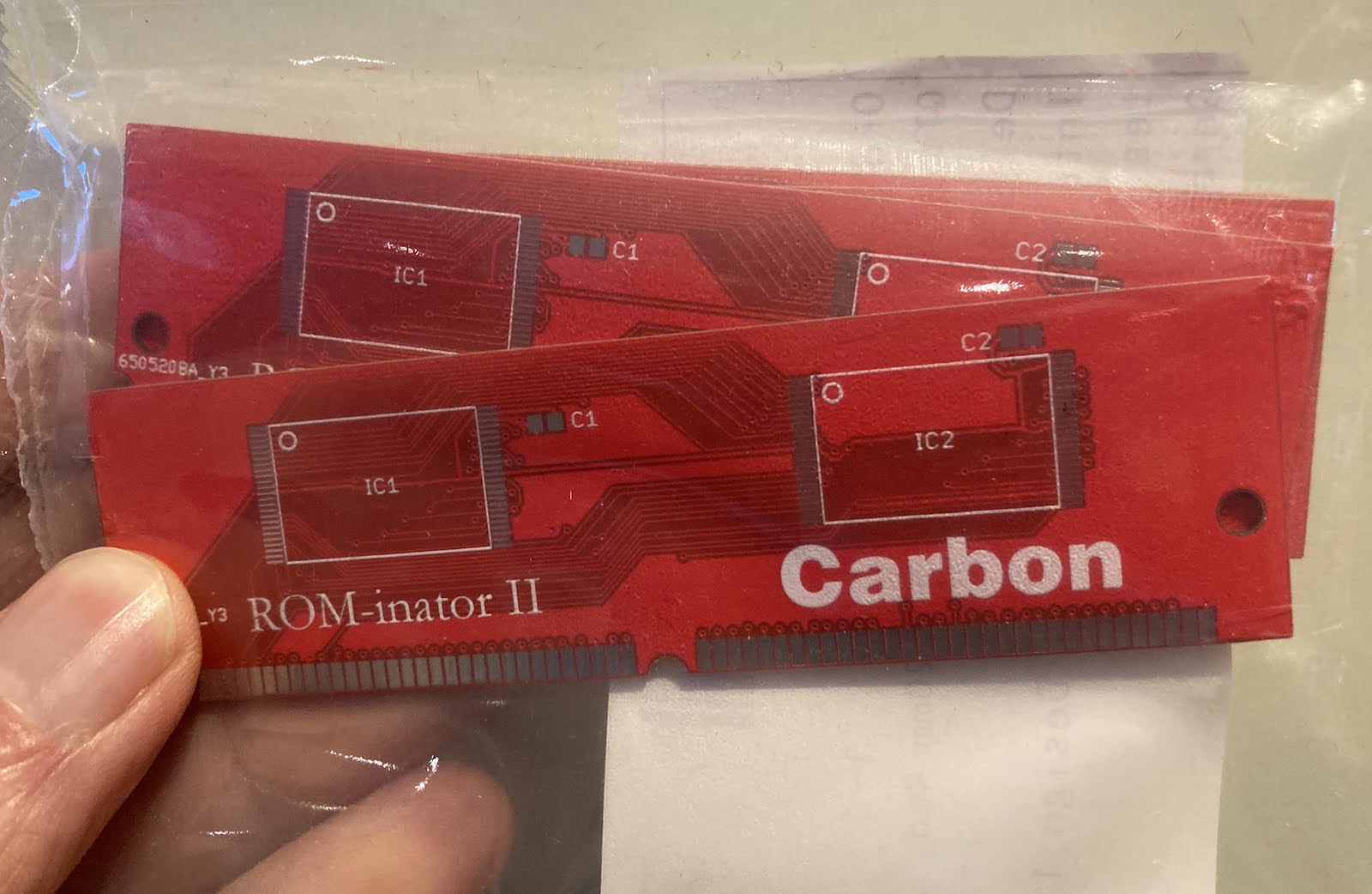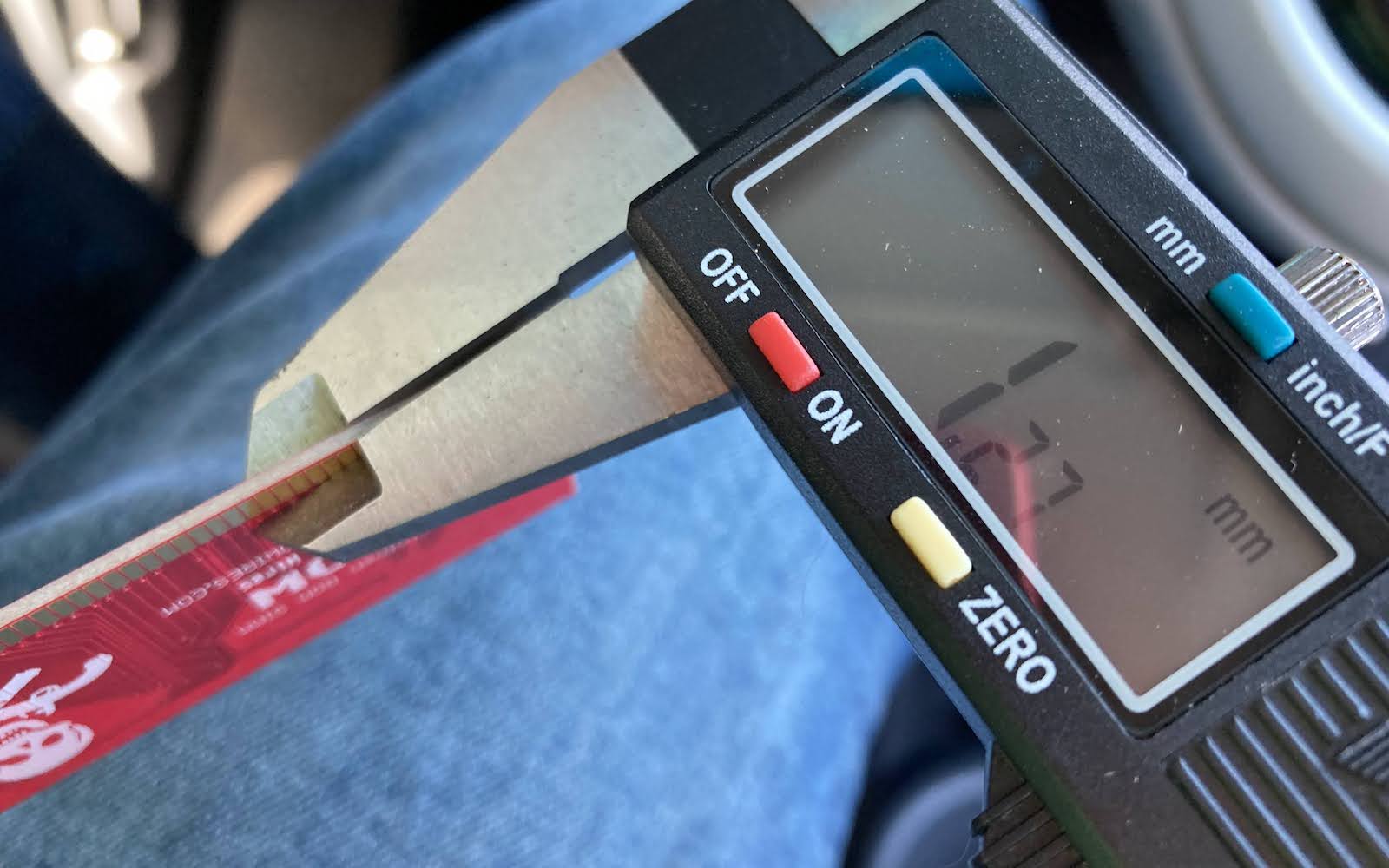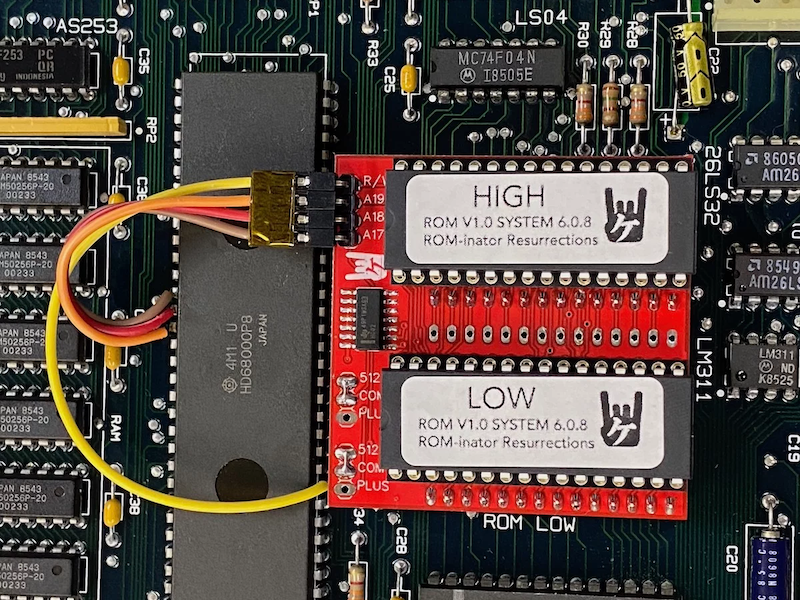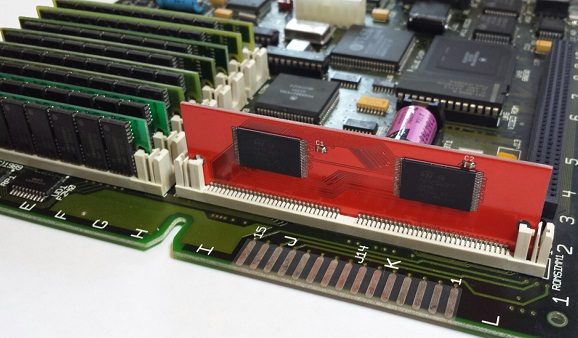Archive for the 'ROM-inator' Category
New Product and Mea Culpa

Today I’m happy to share a long-overdue new product announcement, as well as a firmware update for the BMOW Floppy Emu disk emulator.
The new product is an updated Macintosh ROM SIMM, the Mac ROM-inator II Carbon, which has replaced the ROM-inator II Atom. The Carbon has already been in the BMOW store for several months, but I never got around to formally announcing it until today. Like all versions of the ROM-inator II, the Carbon offers a great upgrade for the the Macintosh SE/30, IIx, IIcx, IIci, IIfx, and IIsi, offering a bootable ROM disk, 32-bit cleanliness, HD20 hard disk support, and more. The Carbon has twice as much memory (4 MB) as the previous ROM-inator model, which enables the storage of a substantially larger compressed ROM disk. The Carbon’s ROM disk contains a full version of System 7.1 along with a suite of recovery/diagnostic utilities that have proven useful. Compared to the Atom, the Carbon has a larger selection of utilities and games, and the System folder is more amply populated.
Version 250225A of the Floppy Emu firmware addresses a bug that affected some WOZ disk images for Apple II computers, causing them to fail to load correctly, and making it difficult or impossible to format WOZ images. I only became aware of this bug a few days ago, but determined that it’s been present since November 2022! I am scratching my head over how it could have been broken for so long without me or anyone else noticing. Probably we all chalked up any WOZ problems we encountered to other issues, and didn’t notice that disks that worked in 2021 and early 2022 firmware versions did not work under later firmware versions. If you use WOZ disk images frequently with your Floppy Emu and Apple II, you’ll definitely want to get this update. The Macintosh/Lisa version of the firmware was not affected and has not changed. Apologies for letting this issue go undetected for so long!
Read 1 comment and join the conversationMac ROM-inator II Restock and Partnerships

The Mac ROM-inator II is back in stock – get yours now at the BMOW Store. The ROM-inator II is a replacement ROM SIMM for Macintosh II series computers and the Mac SE/30, adding a bootable ROM disk, 32-bit cleanliness, HD20 hard disk support, and more. Read more about it at the project’s home page. This is the 1.27 mm (0.05 inch) custom SIMM thickness that works best in finicky SIMM slots like those found on the SE/30.
Policies and Partnerships
The Macintosh ROM SIMM landscape has changed significantly since I started selling them in 2016. At that time, BMOW was the only vendor making and selling custom Mac ROM SIMMs, and the “product” was a combination of hardware and software. The hardware was the SIMM PCB and flash memory chips, while the software was a unique base ROM implementing on-the-fly decompression of a ROM disk image, auto-detection of the memory configuration, a new startup chime, and more. Sales of the hardware subsidized my development work on the base ROM software.
In the last few years, several other vendors have begun selling Mac ROM SIMMs too. Friendly competition is great, but it creates a potential dilemma for me if someone buys another vendor’s ROM SIMM and reprograms it with BMOW’s base ROM in order to get the on-the-fly ROM disk decompression and other features. It could turn into a situation where my base ROM software is subsidizing another competing product. To compound the problem, I didn’t have any clear usage policy or “license” for the base ROM to say whether this type of use was OK. Furthermore my FC8 compression algorithm is free open-source, but the BMOW base ROM which incorporates it is not. This all created a large gray area.
I hope to clarify this now by making the BMOW base ROM image explicitly free for personal use with anybody’s own Mac ROM SIMM, no matter what vendor they purchased it from. This is the simplest and best way of resolving the ambiguity for the benefit of the classic Mac community. I only ask that you don’t resdistribute the base ROM image elsewhere – come back to the BMOW Mac ROM-inator II details page if you need to download the image.
For vendors who might be interested in selling a version of their Mac ROM SIMM that’s pre-programmed with the BMOW base ROM software, I’m happy to partner with you. Please contact me to discuss it. CayMac Vintage and BMOW have recently partnered to bring the BMOW base ROM to their Mac ROM SIMM hardware, which you can check out here. Exciting stuff, and I’m glad to see new energy in this space that will benefit the classic Mac community at large.
The current state of custom Mac ROM SIMM technology is the result of hard work by many people stretching back 20 years: Gamba, Jeff Walther (trag), Doug Brown (dougg3), Rob Braun, myself, and many others. I wish you exciting ROM adventures, friends!
Read 1 comment and join the conversationROM-inator Resurrections

Good news! Kay Koba at Kero’s Mac Mods store is now selling pre-packaged ROM-inator kits for the Macintosh Plus, Mac 512Ke, 512K, and 128K. This is a recreation of the original Mac ROM-inator kit that I designed in 2015. The design is open source, and Kay’s new version is called “ROM-inator Resurrections”.
The ROM-inator replaces the stock 64K or 128K of ROM in a compact Macintosh with a full 1 MB of flash memory. Once installed, the flash ROM’s contents can be updated via software from within the running Macintosh, allowing for extensive customization. The replacement ROM adds a bootable ROM disk to your Macintosh, provides built-in HD20 disk support, replaces the startup sound, changes the Happy Mac icon, and makes it possible to edit the ROM disk or even tweak the ROM toolbox code code.
- Startup beep is replaced by a glass “ping”
- Happy Mac icon is replaced by a Mac wearing sunglasses
- Pirate icon is displayed while waiting to load the ROM disk
- ROM disk image including System 6, Mac Write, Mac Draft, and eight games
- 128K ROM code turns a Mac 128K or 512K into a 128Ke or 512Ke
The ROM-inator is a descendant of Rob Braun’s original Mac Plus ROM Adapter and disk driver. More details about its inspiration and development are here.
When first powered on, the Macintosh will play a customized startup sound, and display a “pirate Macintosh” icon. To boot from the ROM disk, press and hold the R key on the keyboard for a few seconds. If R is not pressed, the Macintosh will boot normally from an attached SCSI disk, or wait for a floppy disk to be inserted.

The utility program Flash Tool can update the flash ROM from within the running Mac. Alternatively, the flash chips can be removed from their sockets and reprogrammed using a standard EPROM programmer.

You can buy a ROM-inator Resurrections kit from Kero’s Mac Mods store. Please refer to their store with any questions or tech support needs; BMOW does not provide any support for these.
Happy ROM hacking!
Read 1 comment and join the conversationBMOW Product Updates


The Mac ROM-inator II is back in stock – get yours now at the BMOW Store. The ROM-inator II is a replacement ROM SIMM for Macintosh II series computers and the Mac SE/30, adding a bootable ROM disk, 32-bit cleanliness, HD20 hard disk support, and more. Read more about it at the project’s home page.
The instruction manual for the BMOW Floppy Emu disk emulator is now available in Japanese. Thanks to Kay Koba for the translation work. Floppy Emu is a floppy and hard disk emulator for classic Apple II, Macintosh, and Lisa computers. It uses an SD memory card and custom hardware to mimic an Apple floppy disk and drive, or an Apple hard drive. The Emu behaves exactly like a real disk drive, requiring no special software or drivers.
Read 1 comment and join the conversationMac ROM-inator II: The Thickening


The Mac ROM-inator II is back in stock – get yours now at the BMOW Store. The ROM-inator II is a replacement ROM SIMM for Macintosh II series computers and the Mac SE/30, adding a bootable ROM disk, 32-bit cleanliness, HD20 hard disk support, and more. Read more about it at the project’s home page.
One small mystery has followed the Mac ROM SIMM project from its earliest days, even before BMOW took over the project from Doug Brown. Experience has found the Mac SE/30 to be much pickier about replacement ROM SIMMs than other Macintosh II series computers. On many SE/30 machines, the computer won’t boot with a ROM-inator II SIMM installed until the SIMM is shimmed or braced with clips or rubber bands. Why? Neither Doug nor I ever found a satisfactory answer. While it isn’t difficult to do, it’s an added step that isn’t needed for other machines.
Over the years, a few SE/30 owners have suggested the ROM-inator II SIMM is too loose in the SE/30 ROM socket, and one person had success manually tinning the SIMM pads to make them slightly thicker. I was never fully convinced about this theory. Why would it only affect the SE/30 and not other machines? And anyway the replacement SIMM was the same thickness as the original ROM SIMM (about 1.2 mm), to the limit of my caliper’s measuring abilities. The exact thickness is hard to pin down, since it varies slightly at different regions on the PCB, and there’s also a +/- 10% thickness tolerance from the manufacturer.
I recently learned something that made me reconsider the thickness theory. Back in 1970s and 1980s, PCB thickness was sometimes specified in mils (thousands of an inch) rather than in millimeters. 50 mil PCBs (1.27 mm) were a common thickness, but today these have all but disappeared. Now 1.2 mm is the closest standard thickness, and that’s what was used for all the previous generations of ROM-inator SIMMs.
Is it possible the original SE/30 SIMM was 50 mils (1.27 mm) nominal thickness, with a matching thickness socket, while all the other Macintosh II models used 1.2 mm nominal SIMMs and sockets? That would be a little surprising, but it could explain the behavior I’ve seen. With a 10% thickness tolerance, that means original SE/30 ROM SIMMs would be anywhere from 1.14 to 1.40 mm thick, and ROM-inator II SIMMs would be anywhere from 1.08 to 1.32 mm thick. It’s conceivable that the ROM-inator II SIMMs at the thin end of the distribution, under 1.14 mm thick, might have trouble in SE/30 machines.
It’s still just a theory, but it seems like a plausible one. I spoke to my local SIMM manufacturing partner about getting a thicker PCB, but unfortunately 50 mil PCBs were not available. To complicate matters further, if you’re concerned about differences of a hundredth of a millimeter, then you also need to consider the thickness of the PCB’s copper layer and any plating on the copper. Much of this calculation went over my head, but eventually my local partner was able to find a Korean manufacturer who could create a 1.27 mm stackup with 10% tolerance. The new batch of ROM-inator II SIMMs in the store today were made by that manufacturer.
So there you have it. If I’ve done this correctly, the nominal thickness of a new ROM-inator II SIMM should be a whopping 0.07 mm greater than before, an increase of about six percent. Will that do anything to help the SE/30? Especially when the thickness tolerance is still larger than the new increase in thickness? Honestly I’m not sure, but I’m interested to find out. Maybe it will behave the same as the ones from the previous manufacturer, which would be anti-climactic but fine. Or maybe it will provide some new clues for this long-running SE/30 ROM SIMM mystery.
Read 5 comments and join the conversationMac ROM-inator II is Back!

The Mac ROM-inator II replaces the stock ROM in the Macintosh SE/30, IIx, IIcx, IIci, IIfx, or IIsi, adding a bootable ROM disk, 32-bit cleanliness, HD20 hard disk support, and more. I had to discontinue this little guy in February, due to unavailability of flash memory chips and heavy product support needs. I’m happy to report that I’ve found a new flash memory provider, and streamlined the product a bit, enabling the reintroduction of ROM-inator II SIMMs today.
The new version is the ROM-inator II Atom, replacing the old Basic and Mega designs while retaining the same overall concept and compatibility. The contents of the built-in ROM-disk on this 2MB ROM module have been refocused to setup, recovery, and utility purposes rather than gaming. The ROM disk contains:
- System 7.1, with System Update 3.0 and Apple CD-ROM Extension 5.3.1
- HD SC Setup 7.3.5 (patched to support formatting non-Apple hard disks)
- SCSI Probe 3.3 (for troubleshooting the SCSI bus)
- ResEdit 2.1.3
Even when booting from a regular hard drive instead of the ROM disk, you still get the benefits of 32-bit cleanliness, HD20 hard disk support, a boot menu, and custom Happy Mac icon and startup chime.
Read more about the ROM-inator II Atom at the product page, or buy one now at the BMOW Store.
Read 5 comments and join the conversation
